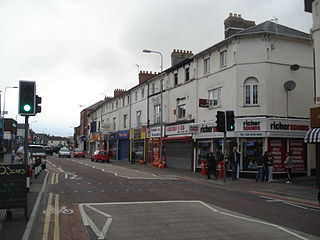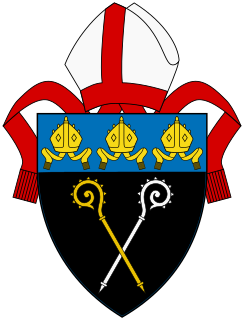
Cardiff is the capital and largest city of Wales. It forms a principal area, officially known as the City and County of Cardiff, and the city is the eleventh-largest in the United Kingdom. Located in the south-east of Wales and in the Cardiff Capital Region, Cardiff is the county town of the historic county of Glamorgan and in 1974–1996 of South Glamorgan. It belongs to the Eurocities network of the largest European cities. A small town until the early 19th century, its prominence as a port for coal when mining began in the region helped its expansion. In 1905, it was ranked as a city and in 1955 proclaimed capital of Wales. Cardiff Built-up Area covers a larger area outside the county boundary, including the towns of Dinas Powys and Penarth.

Llandaff is a district, community and coterminous electoral ward in the north of Cardiff, capital of Wales. It was incorporated into the city in 1922. It is the seat of the Bishop of Llandaff, whose diocese within the Church in Wales covers the most populous area of Wales.

Llandaff Cathedral is an Anglican cathedral and parish church in Llandaff, Cardiff, Wales. It is the seat of the Bishop of Llandaff, head of the Church in Wales Diocese of Llandaff. It is dedicated to Saint Peter and Saint Paul, and three Welsh saints: Dubricius, Teilo and Oudoceus. It is one of two cathedrals in Cardiff, the other being the Roman Catholic Cardiff Metropolitan Cathedral in the city centre.

Radyr is an outer suburb of Cardiff, about 4 miles (6.4 km) northwest of Cardiff city centre. Radyr is part of Radyr and Morganstown Community, for which the 2011 Census recorded a population of 6,417.

Gabalfa is a district and community in the north of the city of Cardiff, capital of Wales. It is characterised by a four-lane fly over road at the Gabalfa Interchange, where the A48 road meets the A470 road which leads from Cardiff to northern Wales, and the A469 road.
The Bishop of Llandaff High School is a Church in Wales, Christian faith comprehensive school in the Llandaff area of Cardiff, Wales. The school admits both male and female students aged 8 to 18, from Cardiff and surrounding areas such as Vale of Glamorgan, Pontypridd and Bridgend. While the school is supported and partially controlled by the Church in Wales, it includes students from other Christian denominations.

A commote was a secular division of land in Medieval Wales. The word derives from the prefix cym- and the noun bod. The English word "commote" is derived from the Middle Welsh cymwt.

Canton is an inner-city district and community in the west of Cardiff, capital of Wales, lying 2 miles (3.2 km) west of the city's civic centre. Canton is one of the most ethnically diverse of Cardiff's suburbs, with a significant Pakistani and Indian population. The total population of Canton increased to 14,304 at the 2011 census. It is also the most Welsh-speaking district of central Cardiff, with 19.1% of the population speaking Welsh.
Gwynllŵg was a kingdom of mediaeval Wales and later a Norman lordship and then a cantref.

A cantref was a medieval Welsh land division, particularly important in the administration of Welsh law.

The Diocese of Llandaff is an Anglican diocese that traces its roots to pre-Reformation times as heir of a Catholic bishopric. It is headed by the Bishop of Llandaff, whose seat is located at the Cathedral Church of Saint Peter and Saint Paul in Llandaff, a suburb of Cardiff. It currently covers most of the former Welsh county of Glamorgan, but once stretched from the River Towy to the middle of the Wye Valley.

The Bishop of Llandaff is the ordinary of the Church in Wales Diocese of Llandaff.

Fairwater is a district and community in the west of Cardiff, capital of Wales. It is located a few miles from Culverhouse Cross which connects Cardiff to the M4 motorway. The population taken at the 2011 census was 12,981.

The Hundred of Dewisland was a hundred in northwest Pembrokeshire, Wales. Formerly the pre-Norman cantref of Pebidiog, it included the city and the peninsula of St Davids. It was named after Dewi Sant, the Welsh name for Saint David.

The Hundred of Dungleddy was a hundred in the centre of Pembrokeshire, Wales. It had its origins in the pre-Norman cantref of Deugleddyf. It derives its Welsh name from its position between the two branches of the River Cleddau (Cleddyf): the English form is a corruption of the Welsh. The area of the cantref was around 185 km2: it was the smallest of the seven cantrefi of Dyfed.

Broadcasting House was the headquarters of BBC Cymru Wales' radio, television and online services, situated in north Cardiff. The purpose-built facility opened in 1966 and consists of three blocks containing studios, offices and technical facilities. In 2020 the BBC moved out, transferring to BBC Cymru Wales New Broadcasting House in Central Square, Cardiff. The building was demolished in 2021 to 2022, with the site to be used for housing.
Ewyas was a possible early Welsh kingdom which may have been formed around the time of the Roman withdrawal from Britain in the 5th century. The name was later used for a much smaller commote or administrative sub-division, which covered the area of the modern Vale of Ewyas and a larger area to the east including the villages of Ewyas Harold and Ewyas Lacy.

John Prichard was a Welsh architect in the neo-Gothic style. As diocesan architect of Llandaff, he was involved in the building or restoration of many churches in south Wales.

Llanilid is a small settlement of in the county borough of Rhondda Cynon Taf, Wales. It is in the historic county of Glamorgan. Llanilid is part of the community of Llanharan along with the villages of Bryncae, Brynna, Ynysmaerdy, Peterston-super-Montem and Llanharan itself.
Cantref Coch was a cantref associated with the kingdoms of Ergyng, Gwent and the later Kingdom of Glamorgan. Its area is defined as the land between the River Severn and the River Wye, with the Severn Sea as its southern border although its northern border is less certain. Cantref Coch is one of the few medieval cantrefi named by Welsh writers that is not within the modern nation of Wales.















